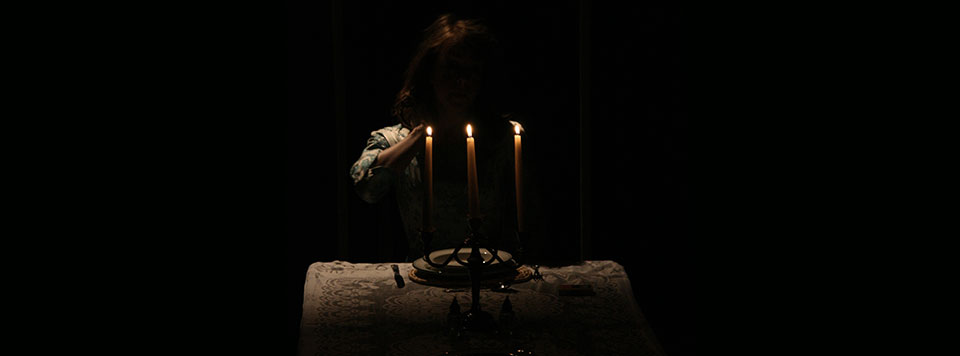Mrs Lazarus
2009
Based on the poem of the same name by Carol Ann Duffy, Mrs Lazarus is a one-act opera for soprano and ensemble. It was first performed by Radius at the Southbank Centre in London in 2009, with Danae Eleni as the protagonist.
Characters
A Woman / "Mrs Lazarus" (soprano)

About the opera
This article was written for the world premiere performance, at which the work was performed alongside Berg’s Piano Sonata and Schoenberg’s Chamber Symphony No. 1.
Both Schoenberg and Berg — alongside whom my Mrs Lazarus is presented tonight — are considered “Expressionists”, and in many ways my new work owes a debt to these composers. But what is “Expressionism”?
Music has, of course, long been associated with the concept of “expression”, but it was in the 19th-century that expressive music came to represent — or express — feelings and emotions. Modulations in key became a metaphor for shifts in feeling, out-of-place harmonies might represent strong emotions, and extreme chromaticism might correspond to a troubled psyche. Indeed, later in that century, these techniques (for example in Wagner) often completely overshadowed any substructure and became an end in themselves.
Expressionism is fascinated with the shifting, ambiguous world of the subconscious, not the relatively objective reality of the conscious world. After Wagner, the masters of Expressionism in music were undoubtedly Schoenberg and Berg, exploring the dark motives of the mind in works such as Erwartung and Wozzeck. This music has had a great influence on me, and finds particular voice in my new work Mrs Lazarus.
The literal narrative of Carol Ann Duffy’s poem is obvious: a woman’s husband dies, she gradually forgets him, and then he comes back to life, like a zombie from Michael Jackson’s Thriller. The title refers to the Biblical Lazarus of Bethany, miraculously restored to life after four days by Jesus.
Duffy’s poem, however, is (in my reading at least) nothing to do with the Biblical story, and is not intended as a literal narrative of an implausible event. For me, it takes place purely in the mind of a bereaved woman. She recounts the grieving process, how her husband gradually fades from her memory; first a visceral reaction (howling, shrieking), then the practical matter of dealing with his possessions, and finally the physical evidence fades (his hair, his scent), until all that is left is the cold, hard “zero” of her wedding ring. This is retold in the past tense, and is therefore not a narrative of events but a sequence of memories.
From the 6th stanza, the tense shifts; the woman has until now been faithful “for as long as it took” — implying that she is now ready to move on to another lover — the images are of fresh air, night, and a hare “thumping” from a hedge, all suggestive, delicately, of a new coupling. As soon as this happens, and we can all too easily imagine it, the memory of her husband (not only, but also the mother-in-law and her “crazy song”!) comes roaring back to catch her in flagrante delicto, to fill her with guilt and shame. The Biblical connection is a reflection that the story is undoubtedly universal: rather than Jesus performing miracles, our own psyches will bring back the dead at the least expected times.
All of these feelings and emotions are powerfully expressed in the narrative aspect of the poem, and offered me a perfect source with which to combine musical “Expressionism”. My music, therefore, is bound up in the succession of memories, thoughts and feelings of the grieving protagonist. The soprano does not merely sit above an accompaniment, but her music is one and the same with the music of the instruments.
Beyond Expressionism, there is also a passing acquaintance in my Mrs Lazarus with the music of Schoenberg and Berg: the harmony is strongly “quartal” (based on the interval of the fourth) and the motif (heard first at the very beginning) of open fifths in the violin is strongly reminiscent of Berg’s Violin Concerto. My music uses somewhat later techniques than the other music in tonight’s programme, drawing on Schoenberg’s twelve-note technique but also (as found in both the Chamber Symphony and Berg’s Piano Sonata) the principle of “continuous development”.
Duration
20 minutes
Instrumentation
Soprano, fl(+picc), cl(+bcl), vn, vc, pf
First performance
Radius at the Southbank Centre in London in 2009, with soprano Danae Eleni
Video
The following video/slideshow is from a production by Re:Sound at the Royal Northern College of Music in Manchester, March 2012 (New Music North-West festival) featuring soprano Rebecca Lea, directed by Katherine Wilde.
Request a score / parts
If you would like to see a score and/or require a set of parts for this music, please contact me.